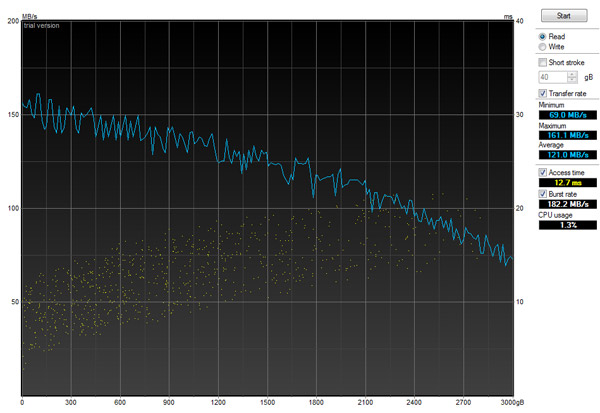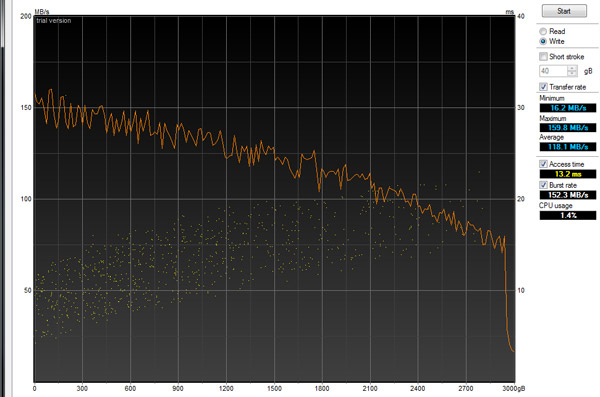The World's First 3TB HDD: Seagate GoFlex Desk 3TB Review
by Anand Lal Shimpi on August 23, 2010 12:39 AM EST- Posted in
- Storage
- Seagate
- HDDs
- GoFlex Desk
Performance vs. Capacity
I typically turn to HDTach for my performance vs. capacity graphs. Normally they are used to show SSD performance degradation without TRIM but in this case I genuinely wanted to see what the performance falloff was as you filled the drive up. HDTach had issues with the > 2TB of addresses on this drive so I used HD Tune instead.
Hard drives store data in circular patterns. Reading/writing to the outermost LBAs is faster (that’s just how circles work, you can cover more area in a single rotation on the outer track vs. the inner track). As a result, HDDs write data at the outmost part of the platters first and as the drive fills performance drops.
Sequential Read Performance vs. LBA

Sequential Write Performance vs. LBA

Peak performance, we’ve already discussed is at around 150MB/s over USB 3.0. Sequential performance at the highest LBAs drops to around 75MB/s. There’s one anomaly that I saw in my tests which you can see in the graph above. Performance drops down to 16.2MB/s for sequential writes in the last 100GB of the drive. This could be a problem with my particular drive or an issue related to the early nature of these 3TB drives.










81 Comments
View All Comments
zdzichu - Monday, August 23, 2010 - link
In first performance table you switched results for SATA and USB3.0 of 3TB drive.oc3an - Monday, August 23, 2010 - link
The maximum integer which can be represented with 32 bits is 4294967295 i.e. 2^32 - 1 which allows for 4294967296 values. The article is worded incorrectly.mino - Monday, August 23, 2010 - link
"...so the largest partition you can have in a MBR partitioned drive is 4294967296 * 512-bytes or 2,199,023,255,552 bytes..."Are you sure that is an incorrect wording?
mino - Monday, August 23, 2010 - link
BIOS does support booting from GPT.It is the Windows boot loader that cannot boot from GPT on BIOS systems.
As a matter of fact I am writing this from Gigabyte 780G board running Ubuntu 10.04 on top of GPT(on top of LVM on top of MD on top of GPT).
yuhong - Monday, August 23, 2010 - link
To be more precise, all that BIOS does is read the first sector of the drive, check for the signature at the end, and if it matches, then it jumps to the real mode x86 code at the beginning. It is actually partition scheme agnostic. Now some BIOSes are not quite partition scheme agnostic and will rely on the contents of the first sector being in the MBR format, luckily GPT support a protective MBR.baker269 - Monday, August 23, 2010 - link
I would love to see what the Ethernet speeds are like. Not that great I would guess since it's not a true NAS, but still would be nice.mindless1 - Monday, August 23, 2010 - link
?? It doesn't have an ethernet interface does it? Speeds would be similar enough to any current-gen 7200 RPM drive already in a system on your LAN.baker269 - Tuesday, August 24, 2010 - link
From the forth paragraph of the article."The drives themselves are standard 3.5” hard drives in a plastic enclosure designed to mate with GoFlex Desk adapters that add USB 2.0, USB 3.0, FireWire 800 or Ethernet connectivity to the drive."
It"s not as easy as just plugging in a hard drive with a RJ45 to a router, there needs to be some kind of CPU in between the two. NAS performance through Ethernet varies greatly.
derkurt - Monday, August 23, 2010 - link
Is it such a big deal that Windows doesn't boot from GPT drives if the BIOS is not EFI-capable? Whoever spends 400+ USD on a drive probably just needs lots of storage space for plain data. It's unlikely that there is no fast boot drive present in any system this drive is plugged into. Actually, since the first expansive 3 TB drives are bought by enthusiasts, chances are that the customers are already using an SSD as a boot drive.That said, in a realistic setting for a performance workstation with Windows 7 x64 installed on a 80+ GB SSD, there won't be a problem. You can connect the drive to the internal SATA connector, partition it with GPT and start using it, while your BIOS doesn't need to know anything about EFI or GPT. The heat issues might also look better when using the drive internally.
I don't understand why Seagate is holding back with selling the internal model. An estimated 95% of users will never even try to boot from it, and for the rest (who do want to boot from it but don't know about the 2+ TB issues), there could be a red warning note inside the box explaining the juicy details. After all, those who spend such an amount of money on a hard drive are not exactly the kind of people who have no clue about hard drives at all.
dryloch - Monday, August 23, 2010 - link
One of Seagates biggest advantages has been that their external hard drives come with a 5 year warranty. Why would they go to a two year warranty on the most expensive drive they sell? If anything they should have at least gone with three years. If they don't even trust this drive then I sure won't. I'll be waiting for Western Digital to have their drive out.